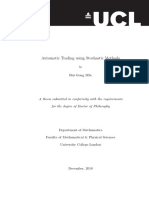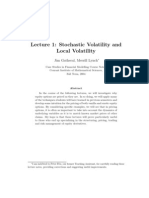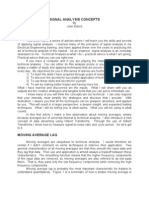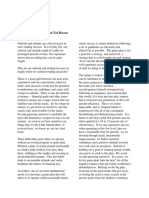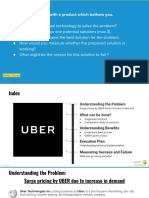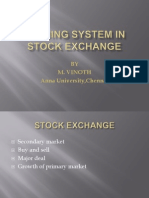A Stock Market Model - Notes
A Stock Market Model - Notes
Uploaded by
shadow slayerCopyright:
Available Formats
A Stock Market Model - Notes
A Stock Market Model - Notes
Uploaded by
shadow slayerOriginal Title
Copyright
Available Formats
Share this document
Did you find this document useful?
Is this content inappropriate?
Copyright:
Available Formats
A Stock Market Model - Notes
A Stock Market Model - Notes
Uploaded by
shadow slayerCopyright:
Available Formats
Level 02
______________________________________________________________________________________________
32. A Stock Market Model
Learning Objective Statements
1. Define an environmental model
2. Contrast internal and external indicators
3. Sketch the basic components of Davis′ Fab Five model
A Stock Market Model
1. The goal of any NDR model is to keep us open—minded and disciplined, and to let our profits run
while avoiding big mistakes.
2. We realize models can be quite fickle, no matter what their ingredients are or how they are built.
3. This model is no exception (there are no exceptions!). The game is to recognize potential
capriciousness and pay attention to the effectiveness of each individual component and to the overall
mix of indicators.
4. One must always be vigilant when depending on models
5. The Fab Five is an environmental model that uses what we call modes.
6. Its job is to assemble the major internal and external factors that affect markets and combine them to
produce a single objective verdict: bearish, neutral, or bullish.
7. Offering only three possibilities might seem a bit too simplistic, like asking someone to rate a product
on a scale of 1 to 3, instead of 1 to 10.
8. But the goal is to keep things simple, and as you will see later, each mode can be open to subtle
interpretation.
9. Just what is an environmental model? In essence, it's one that can keep risk at arm's length without
sacrificing too much on the long side.
10. Such models effectively gauge how good conditions are for investing: do we have calm waters or are
we about to enter the lower 40 latitudes? An environmental model takes into account what the Federal
Reserve is doing, what the so—called smart money is doing, how speculators are feeling, what
interest rates and inflation are doing, and, above all else, what the primary trend is.
11. Using a weight—of—the—evidence approach gives us an educated feel for the risks in the market.
12. The environmental model's job is not necessarily to give concrete buy and sell signals.
13. Its job is to measure the level of risk in the market.
14. We look at two types of indicators:
a. Internal indicators
i. Internal indicators relate to the price action of a market or index and include the usual
list of suspects, along with a multitude of variations: moving averages, momentum,
advances and declines, and volume trends.
ii. All of these can be found in the bottomless bag of tools used by the creative technical
analyst.
iii. I've seen enough momentum tricks alone to last a career. Ditto for moving averages.
www.yubha.com | December, 2022 Edition
Level 02
______________________________________________________________________________________________
iv. There seems to be no end of possibilities when it comes to manipulating an index or its
components in order to come up with a so—called objective opinion on a market's
direction.
v. We break down internal indicators into two distinct types:Trend—following and
Trend—sensitive
vi. Rounding out internal indicators is market breadth, an extremely useful tool in
determining the technical environment.
b. External indicators
i. External indicators include anything outside of price action: the monetary environment,
crowd psychology, valuation, and economic conditions.
ii. At NDR we tend to lump valuation and crowd psychology in the The Sentiment
Component.
iii. We also tend to include economic indicators that can influence markets (e.g., inflation)
in the The Monetary Component and sometimes, to a lesser extent, the sentiment
category.
iv. So basically we're looking at two sets of external indicators: monetary and sentiment.
15. To build a truly diverse, objective model requires finesse, diligence, a bit of artistic panache, and a
strong knowledge of macroeconomic relationships, ranging from company fundamentals to
macroeconomic fundamentals to Fed watching.
16. Ironically, computing power takes a back seat in building good models.
Fab Five
1. To create the Fab Five, we combined individual models covering our favorite areas of the market.
2. However, the model has only four components—The Sentiment Component, The Monetary
Component, Fab Five Combo Component, and the Tape Component—but the tape is given double
weight.
www.yubha.com | December, 2022 Edition
Level 02
______________________________________________________________________________________________
3. Figure 30.1 shows the past 10 years of the Fab Five model.
4. The mode boxes at the bottom summarize the results for the full date range as well as for the past 10
years.
5. The top clip has an additional series on it that represents an equity line based on going long the S&P
500 when the model is above the upper bracket, going into T–bills when the model is between the
brackets, and shorting the S&P 500 when the model is below the lower bracket. This equity line is
only for perspective; it's there to give a close–up view of how the model has behaved in the past. The
stats tell a story, but not the whole story.
# Summing Up the Fab Five
1. Each component model is reduced to +1, 0, or –1 (with the exception of the tape component, which
gets +2, 0, or –2), and the result is a simple sum.
2. This leaves the overall model's range at –5 to +5, with the brackets set at –1.5 and 1.5
# How We Use the Fab Five
1. I opened this chapter explaining that the Fab Five is an environmental model that provides a unified
view and ties together sometimes opposing investment themes.
2. If the model is outright bullish then our outlook will be on the bullish side.
3. If it's merely flirting with the upper bracket we might temper our bullishness. We might make a
distinction between high neutral and low neutral, depending on whether the model is moving up or
down. For example, if it shifts from bearish to neutral, we might consider that hopeful. But going from
bullish to neutral could make us cautious.
www.yubha.com | December, 2022 Edition
Level 02
______________________________________________________________________________________________
4. We would never deviate too far from the Fab Five's basic verdict. If it's bullish we won't be bearish: we
might be mildly bullish, but never bearish.
5. Even though this model isn't designed for trading, traders can still use it to make decisions about
whether they should have a bullish or bearish bias. If the short side is your thing then you should be a
little more careful if the Fab Five is in bullish mode, and vice versa. At any rate, we still look to other
inputs when evaluating our market position, but always in the context of the Fab Five.
Tape Component
1. There are seven individual indicators in the tape component.
2. As with all the other Fab Five components, and in keeping with our KISS philosophy, these indicators
are each assigned—1, 0, or +1, and the result is produced through simple addition.
3. The first indicator for Tape Component is the Golden cross.
a. The first indicator in the tape component is shown in Figure 30.2.
4. Stochastic is the Second Indicator
5. Third Indicator is Breadth
a. Moving away from direct price action, we turn to one of our favorite broad–market tool sets:
breadth. This indicator is one of Ned's favorites. It's based on another fairly simple yet effective
concept: evaluating the impact of volume supply and volume demand.
b. To stabilize the volatility and gain a useful perspective, we typically sum both supply and
demand over a substantial period ranging from days to months. The percent of summed
supply volume plus the percent of summed demand volume always adds to 100. They meet in
the middle at 50 percent.
www.yubha.com | December, 2022 Edition
Level 02
______________________________________________________________________________________________
c. The universe we are using for these calculations is the NDR Broad Market Equity Series
All–Cap Index. This index represents 99 percent of the market value of the common shares
trading on the big three exchanges. Its history goes back to September 1980.
d. The mode box in Figure 30.4 shows that when demand has been above supply, as it has been
79.0 percent of the time, the S&P 500 has advanced at 11.8 percent a year. But when supply
is above demand, the market retreats 1.2 percent per annum. This indicator's contribution to
the Fab Five tape component is +1 when demand is above supply and -1 otherwise.
6. Fourth and Fifth Indicator is to look for excitement in the stock market
a. There are many ways to look for excitement in the stock market: exuberance, whether rational
or irrational, can be measurable.
b. A couple of our favorite indicators look at the relationship between advancing and declining
volume, or advances versus declines.
c. Figure 30.5 evaluates the ratio of advances to declines. The ratio is actually a 10–day sum of
NDR Multi–Cap advancing issues divided by a 10–day sum of declining issues. The NDR
Multi–Cap universe covers the top 97percent of tradable market cap and includes the NDR
Large Cap plus the NDR Mid –Cap plus some of the NDR Small Cap (enough to get the
market cap to 97 percent).
d. When the advance/decline ratio exceeds 1.9, we call that a breadth thrust. The table in Figure
30.5 shows the history of this indicator back to 1947. Now I know what you're thinking: Hold
on—if the Multi–Cap started in 1980, just exactly how did you do this? Especially given that
lecture about following only common stocks on the NYSE? Well, we consider ourselves
market historians, and we love historical data—as much as we can get. So yes, we borrowed
the NYSE advance/decline data going back to 1947 to help illustrate the point that breadth
www.yubha.com | December, 2022 Edition
Level 02
______________________________________________________________________________________________
thrusts can be quite significant. It also turns out that, according to our database, stocks other
than common stocks made up only 20 percent of listed NYSE issues in 1980.
e. Now how exactly do we get these thrusts to work for us? Typically, we try to determine how
long initial momentum is likely to last based on history and then refine our prediction from
there. In the case of the indicator shown in Figure 30.5, 80 market days seemed to work well.
But what if a signal is repeated in that period? One could approach it in at least two ways:
either by simply resetting the count every time a new signal occurs in the 80–day window or by
ignoring that signal. After some quick testing we decided on the latter
f. The contribution of this indicator to the Fab Five tape component is either +1 or 0. It can never
go negative.
7. Sixth Indicator is a cool breadth gauge, the high–low logic indicator—developed by Norman Fosback
and shown in Figure 30.6—is it.
8. Seventh Indicator is to go with Mo.
a. A long–standing tenet of NDR is to go with Mo.
b. If the market's momentum is up, we're in; if it's down, we're out. We use this model as a gauge
of technical health.
c. Big Mo is a diffusion index that represents the percentage of bullish individual trend and
momentum indicators taken from 96 of our own BMES subindustry indices. The trend
indicators are based on the direction of a subindustry's moving average, while the momentum
indicators are based on the rate of change of the subindustry's price index. The ratio of
momentum to trend indicators is around two to one.
d. The indicator shown in Figure 30.8 introduces a modification of our standard mode bat: the
directional mode bat. The two mode boxes in the upper left show results based on whether Big
Mo is higher or lower than it was six weeks earlier. In the bottom section, the brackets are
fixed at 56 and 79, and the results are quite different depending on Big Mo's direction.
Whether the model is improving (rising) or weakening (falling) can give valuable information in
www.yubha.com | December, 2022 Edition
Level 02
______________________________________________________________________________________________
addition to the model's current level: when Big Mo Tape has been high and rising, the returns
have tended to be best, while a low and falling model reading has been associated with the
weakest returns
e. The weight of this indicator in the tape component of the Fab Five is tricky but sensible. When
Big Mo is rising and above 56 we assign a +1; when it's rising and below 56, it gets a 0; falling
and above 79 is another +1; falling and between the brackets is a 0, while falling and below 56
gets the only −1 reading. If Big Mo is unchanged on a six–week basis the reading from the
prior week is used.
The Final Tape Component
1. Since there are seven components to the model, the range should be –7 to +7. But remember, the
thrust indicator can't go negative, so the overall sum ranges from –6 to +7.
2. The brackets for the model are set at –1.5 and 25.5 (bottom chart section).
3. As with all of the components of the Fab Five, this model is designed to work in four separate time
frames.
4. Its contribution to the overall [[Fab Five]] is –2, 0, or +2 (remember, it gets double weight).
The Sentiment Component
1. It has Seven Indicators
2. Each indicator Delivers +1,0,-1 with the only exception of Daily Sentiment Composite (Which gets
double weight)
www.yubha.com | December, 2022 Edition
Level 02
______________________________________________________________________________________________
3. The First sentiment Indicator is Advisors' Sentiment Report
4. The second Sentiment indicator is PE Ratio
a. This indicator's contribution to the Fab Five sentiment component is +1 below 14.5, 0 from
14.5 to 22.5, and –1 above 22.5. This is one of the few Fab Five indicators that is calculated
monthly.
5. Third one is a relative measure of earnings to interest rates.
a. The contribution to the Fab Five sentiment component is –1 below the bottom bracket, 0 in
between the brackets, and +1 above the upper bracket.
6. Fourth Sentiment Indicator is The TRIN (also known as MKDS or the Trading Index)
a. Contribution to the sentiment component is –1 when both TRINs are negative or one is
negative and the other is neutral, 0 when they sum to 0, and +1 when both are positive or one
is positive while the other is neutral.
7. Fifth Sentiment Indicator is a fundamental indicator and is based on its analysts' three– to five–year
PE projections for the stocks in their universe.
a. The contribution to the Fab Five sentiment component is +1 when the six–week smoothing of
the VLMAP drops below the upper bracket and –1 when it moves from below to above the
lower bracket. That sell signal at the end of 2012 looked bad, but in Fab Five reality, it was
negative for only seven weeks before it hit oops, or neutral, mode.
8. Sixth Sentiment Indicator is Daily Trading Sentiment Composite.
a. The contribution to the Fab Five sentiment component is +2 when the daily sentiment
composite is below the lower bracket, 0 in between the brackets, and –2 when above the
upper bracket.
Sentiment Summary
1. The final sentiment component, shown in Figure 30.20, is a sum of the indicators discussed (plus one
more P/E indicator) for a range of –8 to +8 (remember, the daily sentiment composite has double
weight).
www.yubha.com | December, 2022 Edition
Level 02
______________________________________________________________________________________________
2. The brackets are set at –1.5 and 1.5.
3. It attributed to Fab Five
The Monetary Component
1. Our third major piece is the Fab Five monetary component.
2. The adage “money moves markets” is probably as old as the markets themselves; without demand in
some form of purchasing power, there would be no markets.
3. The availability of money equates to liquidity, and measures of liquidity help us get a handle on risk.
Of course, the source and quality of money also matter, and our view of the monetary situation comes
from two major sources: (1) the price of money, meaning interest rates; and (2) the supply of money.
4. Rates of change in interest rates—regardless of what maturities we're looking at or whether we're
examining government or corporate securities—yield consistently good results against the stock
market.(First Monetary Indicator)
5. annual rate of growth of industrial production and the commodity price component of the producer
price index (PPI) subtracted from the 12–month change of the M2 money supply, illustrates the
relationship between monetary and economic environments, with industrial production and PPI
commodities representing the economy and what is produced with available money.(Second
Monetary Indicator ).
6. Deviation–from–trend is the third Monetary Indicator.
7. Inflation is the fourth Monetary indicator
8. AMEX Securities Broker-Dealer Index is the fifth monetary indicator
9. Normalized Federal Reserve Board data is the sixth monetary indicator
10. Fed's influence on the monetary base is the seventh monetary indicator
www.yubha.com | December, 2022 Edition
Level 02
______________________________________________________________________________________________
Monetary Component Summary
1. The final monetary component in Figure 30.28 is a sum of the indicators discussed in the preceding
section (plus an additional interest rate indicator, not discussed) for a range of –8 to +8.
2. The brackets are set at –1.5 and 2.5. Because the brackets are asymmetric, it's easier to get a sell
than it is to get a buy.
3. As with all of our other Fab Five components, this model was constructed to work in all four of our
preset time frames.
Fab Five Combo Component
1. We call it Combo because it's composed of six stock–market models, each with a different mix of
indicators.
2. The six range from the very simple to the very complex, but they each have the same weight.
3. We've found that it helps to have a variety of models, each with its own indicator mix.
4. Aggregating these models produces a consensus to help clarify risk and reward.
Combo Model Summary
1. Since there are six total indicators, the range of the model shown in Figure 30.35 is –6 to +6.
www.yubha.com | December, 2022 Edition
Level 02
______________________________________________________________________________________________
2. The brackets are set at –1.5 and 2.5, and to be consistent with the other major Fab Five components,
the model is designed to work in four preset date ranges.
www.yubha.com | December, 2022 Edition
You might also like
- Weather Wax Bertsimas Solutions ManualDocument20 pagesWeather Wax Bertsimas Solutions Manualchencont0% (8)
- IB bm2tr 3 Resources Answers3Document9 pagesIB bm2tr 3 Resources Answers3PaolaNo ratings yet
- Equity Analytics - Modern Portfolio Theory-Jonathan KinlayDocument7 pagesEquity Analytics - Modern Portfolio Theory-Jonathan KinlaymoinNo ratings yet
- Advice Mark JoshiDocument20 pagesAdvice Mark JoshiSom KumarNo ratings yet
- Moving Average and Exponential Smoothing ModelsDocument13 pagesMoving Average and Exponential Smoothing ModelsP Singh KarkiNo ratings yet
- Assignment 8Document1 pageAssignment 8Revadhi GopalakrishnanNo ratings yet
- Introduction To Fast Fourier Transform inDocument31 pagesIntroduction To Fast Fourier Transform inALNo ratings yet
- Application of Fourier AnalysisDocument5 pagesApplication of Fourier AnalysisMuhammad Ubaid Raza100% (1)
- Monte Carlo Simulation Methods Lecture NotesDocument10 pagesMonte Carlo Simulation Methods Lecture Notesapi-3724597No ratings yet
- Neowave Theory by Glenn Neely. Retracement Rule 6, Conditions "B", "C', and "D"Document11 pagesNeowave Theory by Glenn Neely. Retracement Rule 6, Conditions "B", "C', and "D"SATISHNo ratings yet
- Modern Approaches To Stochastic Volatility CalibrationDocument43 pagesModern Approaches To Stochastic Volatility Calibrationhsch345No ratings yet
- Why Might Share Price Follow A Random Walk by Senior SophisterDocument13 pagesWhy Might Share Price Follow A Random Walk by Senior SophisterHu ShanxiongNo ratings yet
- Simona Svoboda - Libor Market Model With Stochastic Volatility PDFDocument66 pagesSimona Svoboda - Libor Market Model With Stochastic Volatility PDFChun Ming Jeffy TamNo ratings yet
- UCL-Thesis-Hui GongDocument101 pagesUCL-Thesis-Hui GongNapolnzoNo ratings yet
- Leuthold Group - From August 2015Document10 pagesLeuthold Group - From August 2015ZerohedgeNo ratings yet
- Analysis of Stock Market Data by Using Dynamic Fourier and Wavelets TeknikDocument13 pagesAnalysis of Stock Market Data by Using Dynamic Fourier and Wavelets TeknikJauharin InsiyahNo ratings yet
- Option Pricing With Time-Changed Levy ProcessesDocument39 pagesOption Pricing With Time-Changed Levy ProcesseslycancapitalNo ratings yet
- TomT Stock Market Model October 30 2011Document20 pagesTomT Stock Market Model October 30 2011Tom TiedemanNo ratings yet
- Programming Exercise 3: 3D Controller and Trajectory GenerationDocument10 pagesProgramming Exercise 3: 3D Controller and Trajectory GenerationhemanthkandulaNo ratings yet
- T2.Statistics Review (Stock & Watson)Document15 pagesT2.Statistics Review (Stock & Watson)Abhishek GuptaNo ratings yet
- CME DataMine T&S Vs IQFeed's Millisecond Time Stamps - Brokers and Data Feeds - Big Mike TradingDocument16 pagesCME DataMine T&S Vs IQFeed's Millisecond Time Stamps - Brokers and Data Feeds - Big Mike TradingDraženSNo ratings yet
- SSRN Id2607730Document84 pagesSSRN Id2607730superbuddyNo ratings yet
- Heston Jim GatheralDocument21 pagesHeston Jim GatheralShuo YanNo ratings yet
- Confidence Intervals For Kelly CriterionDocument12 pagesConfidence Intervals For Kelly Criterionsuedesuede100% (1)
- D Ifta Journal 10Document76 pagesD Ifta Journal 10zushiiiNo ratings yet
- Catalogue V 04Document7 pagesCatalogue V 04percysearchNo ratings yet
- PT As I Still See It Clean Copy Markowitz 2010Document42 pagesPT As I Still See It Clean Copy Markowitz 2010OVVOFinancialSystemsNo ratings yet
- 20 A Long-Run and Short-Run Component Model of Stock Return VolatilityDocument23 pages20 A Long-Run and Short-Run Component Model of Stock Return Volatilityrob-engleNo ratings yet
- Stochastic Volatiity Models 2005 PDFDocument35 pagesStochastic Volatiity Models 2005 PDFFrancisco López-HerreraNo ratings yet
- Gary Antonacci - Momentum Success Factors (2012)Document33 pagesGary Antonacci - Momentum Success Factors (2012)johnetownsendNo ratings yet
- Signal Analysis ConceptsDocument13 pagesSignal Analysis ConceptsDiddly SquatNo ratings yet
- Approximate Molecular Orbital TheoryDocument221 pagesApproximate Molecular Orbital TheoryGilvan PirocaNo ratings yet
- Download Full Signal Processing and Linear Systems 2nd Edition B. P. Lathi PDF All ChaptersDocument81 pagesDownload Full Signal Processing and Linear Systems 2nd Edition B. P. Lathi PDF All Chaptersmeinarartemo100% (2)
- Predicting Stock Trend Using Fourier Transform and Support Vector RegressionDocument4 pagesPredicting Stock Trend Using Fourier Transform and Support Vector Regression楊明翰No ratings yet
- Option Volatility Greeks-Vega, Volga & VannaDocument9 pagesOption Volatility Greeks-Vega, Volga & VannaPaulo GuerraNo ratings yet
- Ehlers - Non Linear FiltersDocument54 pagesEhlers - Non Linear FiltersJuna NaelgaNo ratings yet
- You Say You're A Trader? It May Be A Tough Game With The IRSDocument68 pagesYou Say You're A Trader? It May Be A Tough Game With The IRSŞamil CeyhanNo ratings yet
- 6 Basic Statistical ToolsDocument30 pages6 Basic Statistical ToolsRose Ann MendigorinNo ratings yet
- Introducing The MIDAS Method of Technical Analysis Lesson 2Document4 pagesIntroducing The MIDAS Method of Technical Analysis Lesson 2King LeonidasNo ratings yet
- Syllabus Nit PDFDocument39 pagesSyllabus Nit PDFDhinasuga DhinakaranNo ratings yet
- EhlersDecycler IIDocument3 pagesEhlersDecycler IIAlireza P100% (1)
- Nomura Warns S&P 500 Options Driven Vol Killer Looms Into Year EndDocument8 pagesNomura Warns S&P 500 Options Driven Vol Killer Looms Into Year EndKien NguyenNo ratings yet
- Distance Weighted Moving AveragesDocument6 pagesDistance Weighted Moving AveragessuperbuddyNo ratings yet
- Introduction To ForecastingDocument22 pagesIntroduction To ForecastingJoe Di NapoliNo ratings yet
- Drummond Geometry 12Document10 pagesDrummond Geometry 12Benjamin TanNo ratings yet
- IITMFRPDocument606 pagesIITMFRPSouba GiridharNo ratings yet
- CH 21 WL Photon Dosimetry Concepts and CalculationsDocument47 pagesCH 21 WL Photon Dosimetry Concepts and Calculationsoomganapathi100% (1)
- Fundamentals of Nuclear Pharmacy 7th Edition Gopal B. Saha (Auth.) All Chapters Instant DownloadDocument52 pagesFundamentals of Nuclear Pharmacy 7th Edition Gopal B. Saha (Auth.) All Chapters Instant Downloadcanetomawetu100% (4)
- Diode Laser SetupDocument16 pagesDiode Laser SetupBodhaditya SantraNo ratings yet
- Dynamics of Financial Markets - Mandlebrot & Beyond Bouchard and BorlandDocument11 pagesDynamics of Financial Markets - Mandlebrot & Beyond Bouchard and BorlandGreg McKennaNo ratings yet
- Predicting Stock Prices With Echo State Networks - Towards Data ScienceDocument19 pagesPredicting Stock Prices With Echo State Networks - Towards Data ScienceMingyu LiuNo ratings yet
- Heath Jarrow Morton A Interest Rate Model For CVA CalculationsDocument9 pagesHeath Jarrow Morton A Interest Rate Model For CVA CalculationsAlexis MaenhoutNo ratings yet
- Project Report Risk and Returns of SecuritiesDocument89 pagesProject Report Risk and Returns of SecuritiesAbhishek ShuklaNo ratings yet
- Chapter 7 - Global Segmentation and Positioning 1Document4 pagesChapter 7 - Global Segmentation and Positioning 1peixuanNo ratings yet
- Financial StatementDocument19 pagesFinancial StatementRanjeet Maurya100% (1)
- ML Yifan Lu REPORTDocument22 pagesML Yifan Lu REPORTrobert.yf.luNo ratings yet
- INSEAD Case Book Template v0.2Document8 pagesINSEAD Case Book Template v0.2Louis Giacomo Pranlas DescoursNo ratings yet
- Rough Notes Exhibit CDocument19 pagesRough Notes Exhibit CKenan FarrellNo ratings yet
- 2011-2016 3rd Lesson Question and AnswersDocument4 pages2011-2016 3rd Lesson Question and AnswersNawoda SamarasingheNo ratings yet
- Relationship of Technology With Wealth of Nation & Firms Specific Knowledge (Competitive Advantage)Document17 pagesRelationship of Technology With Wealth of Nation & Firms Specific Knowledge (Competitive Advantage)Kritika JainNo ratings yet
- 2015 AC3091 Prelim Eqp and CommentaryDocument21 pages2015 AC3091 Prelim Eqp and Commentaryduong duongNo ratings yet
- Bottom of Pyramid Business StrategyDocument36 pagesBottom of Pyramid Business StrategyTyra Lim Ah KenNo ratings yet
- Strategic Valuation IssuesDocument29 pagesStrategic Valuation IssuesMohd Faiz67% (3)
- All Candelestics & Chart Pattern by Sheikh Amir With Chea SheetDocument61 pagesAll Candelestics & Chart Pattern by Sheikh Amir With Chea Sheetfdadf8803No ratings yet
- CH 5 - ESOPDocument34 pagesCH 5 - ESOPVrutika ShahNo ratings yet
- IA SheeetttDocument9 pagesIA Sheeetttkeith tambaNo ratings yet
- Section 11 30 Minutes 25 Questions: GMAT Math Data SufficiencyDocument29 pagesSection 11 30 Minutes 25 Questions: GMAT Math Data Sufficiencyajju1378No ratings yet
- Week 3 NotesDocument14 pagesWeek 3 NotesAndy MoralesNo ratings yet
- CoachDocument5 pagesCoachUmi MuvidahNo ratings yet
- SpreadsheetGuys InvoiceTemplate FREEv1.0Document3 pagesSpreadsheetGuys InvoiceTemplate FREEv1.0Neeraj RajgaurNo ratings yet
- HRM Case StudyDocument3 pagesHRM Case StudyDeepika DwivediNo ratings yet
- Bullish: Option Strategies For Bullish ViewDocument10 pagesBullish: Option Strategies For Bullish ViewAshutosh ChauhanNo ratings yet
- Finding An ApartmentDocument6 pagesFinding An Apartmentapi-276011496No ratings yet
- SM CH05Document26 pagesSM CH05jklein2588No ratings yet
- Alabang Studio PresellingDocument3 pagesAlabang Studio Presellingpatrick salvaniNo ratings yet
- Flipkart APMDocument10 pagesFlipkart APMAyush ChoubeyNo ratings yet
- Market Segmentation, Targeting and PositioningDocument2 pagesMarket Segmentation, Targeting and PositioningDu Baladad Andrew MichaelNo ratings yet
- Assessment of Operational BADocument26 pagesAssessment of Operational BAFaruk HossainNo ratings yet
- Land Building MachineryDocument11 pagesLand Building MachineryJomerNo ratings yet
- Trading System in Stock ExchangeDocument19 pagesTrading System in Stock ExchangeMohan KumarNo ratings yet
- Feai Notes For MbiDocument31 pagesFeai Notes For Mbimohamed abdukadirNo ratings yet
- The Zara Brand StrategyDocument13 pagesThe Zara Brand StrategyAkansha PanwarNo ratings yet
- Organizational Aspect: Jaypee Martin (Manager)Document10 pagesOrganizational Aspect: Jaypee Martin (Manager)Myrna AricillaNo ratings yet














